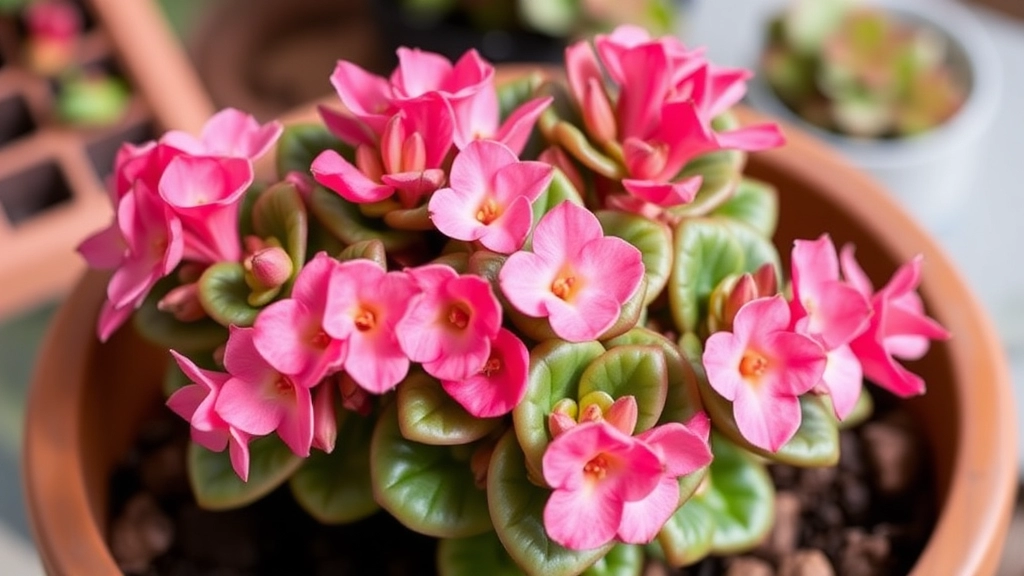How to Care for a Calandiva Kalanchoe Plant
Ever wondered how to care for a Calandiva Kalanchoe plant? Whether you’re a seasoned gardener or just starting out, this guide will help you keep your plant thriving. The Calandiva Kalanchoe is not only beautiful but also low-maintenance, making it a perfect addition to any home.
In this article, I’ll share simple yet effective tips to ensure your Calandiva Kalanchoe plant remains healthy and vibrant. From watering schedules to sunlight requirements, you’ll find all the essential information right here. Let’s dive in!
Overview of Calandiva Kalanchoe Plant
Are you looking for a vibrant addition to your plant collection? The Calandiva Kalanchoe might just be the perfect choice.
This stunning succulent, known for its lush, rosette-shaped leaves and vibrant clusters of flowers, is a popular choice among plant enthusiasts.
- Flowers: The Calandiva Kalanchoe blooms in a variety of colours, including pink, red, and white, making it a delightful sight in any home.
- Size: Typically, this plant grows to about 30cm in height, making it suitable for both small and large spaces.
- Lifespan: With proper care, it can thrive for several years, providing ongoing beauty and joy.
The Calandiva Kalanchoe is not just visually appealing; it’s also relatively low-maintenance, making it an ideal option for beginners and seasoned gardeners alike. For those interested in learning more about caring for this beautiful succulent, check out our complete guide to caring for Kalanchoe succulents. Additionally, if you’re curious about the different varieties of Kalanchoe, our identification guide on top Kalanchoe varieties might be of interest.
Ideal Growing Conditions
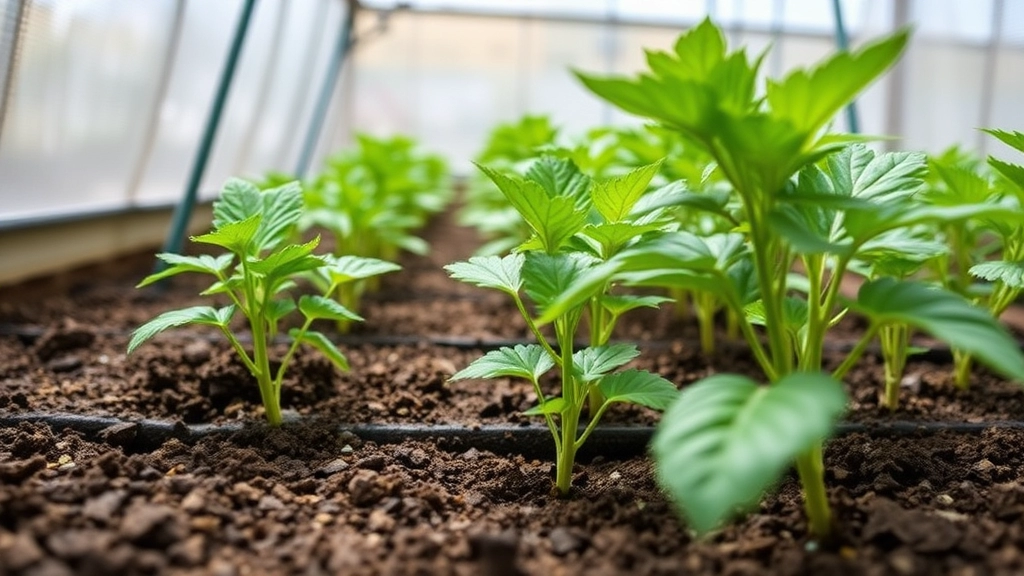
So, you’re keen on growing a Calandiva Kalanchoe? Great choice! But before you dive in, let’s chat about the ideal conditions for this lovely plant.
What Does Your Calandiva Need?
To thrive, Calandiva Kalanchoe needs a few specific conditions:
- Temperature: Ideally, keep it between 15°C to 25°C. They love warmth but can’t handle frost.
- Humidity: Moderate humidity is best. Too much moisture can lead to trouble.
- Air Circulation: Good airflow is key. It helps prevent diseases and keeps the plant happy.
Where to Grow Your Calandiva
- Indoors: A sunny windowsill is perfect. Just make sure it’s not too drafty.
- Outdoors: If you’re in a warmer climate, place it where it gets morning sun and some afternoon shade.
Potting Up
- Container: Choose a pot with drainage holes. This prevents water from sitting at the bottom.
- Size: Go for a pot that’s slightly bigger than the root ball. Too much space can lead to overwatering.
Watering Requirements
When it comes to caring for your Calandiva Kalanchoe, one of the most pressing concerns is how often to water. Overwatering can lead to root rot, while underwatering can cause your plant to wilt and lose its vibrant blooms.
Key Watering Tips:
- Check the Soil: Always assess the moisture level of the soil before watering. Insert your finger about an inch deep; if it feels dry, it’s time to water.
- Water Thoroughly: When you do water, ensure that you soak the soil thoroughly. This encourages deep root growth and helps the plant absorb nutrients effectively.
- Frequency: Generally, watering every two to three weeks is adequate, but this can vary based on the season. In warmer months, you may need to water more often, while in winter, the frequency can decrease.
- Drainage: Make sure your pot has good drainage. Excess water should easily escape to prevent soggy soil.
- Signs of Overwatering: Yellowing leaves and a mushy stem are clear indicators that your Kalanchoe is receiving too much water.
By keeping these watering requirements in mind, you can help your Calandiva thrive and produce stunning blooms. For more detailed information on how to care for your Kalanchoe, check out our complete care guide. If you’re experiencing issues with overwatering, our guide on pruning and care tips can help you address and prevent common problems.
Light and Temperature Needs
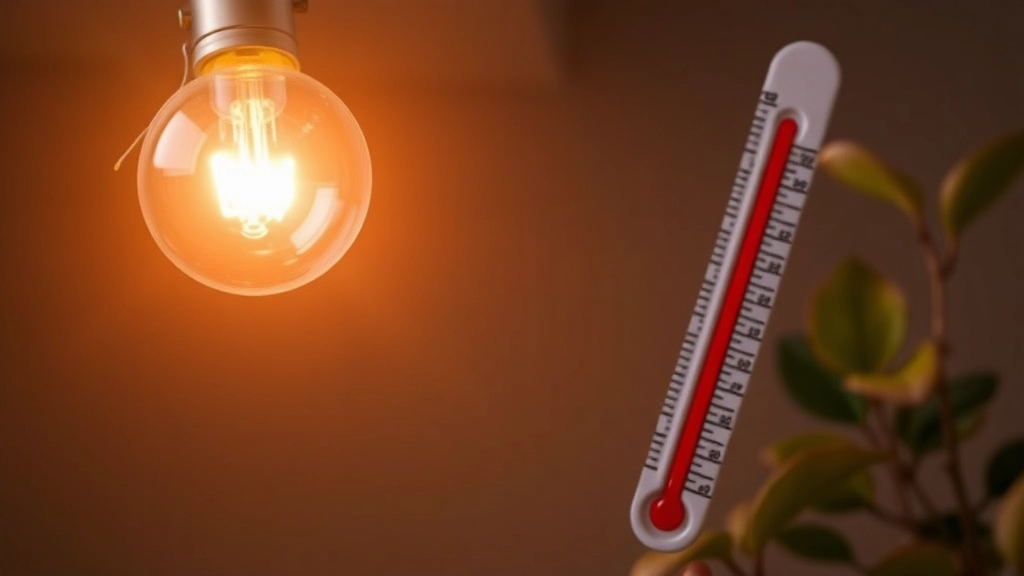
When growing the Calandiva Kalanchoe, many gardeners wonder about the optimal light and temperature requirements to ensure vibrant blooms and healthy foliage.
Light Requirements
Calandiva Kalanchoe thrives in bright, indirect sunlight. Here are some key points to consider:
- Direct Sunlight: While it can tolerate some direct sunlight, prolonged exposure can scorch the leaves.
- Ideal Position: Placing your plant near a south or west-facing window is often the best choice.
- Supplemental Lighting: During the winter months, consider using grow lights to provide additional light if natural sunlight is limited.
Temperature Preferences
Temperature plays a crucial role in the well-being of your Calandiva Kalanchoe:
- Optimal Range: This plant prefers temperatures between 18°C to 24°C (65°F to 75°F).
- Avoid Extremes: Protect your Kalanchoe from cold drafts and extreme heat, as temperatures below 10°C (50°F) can be detrimental.
- Humidity Levels: Moderate humidity is ideal; avoid overly humid conditions to prevent rot.
By ensuring your Calandiva Kalanchoe receives the right amount of light and stays within the preferred temperature range, you set the stage for a flourishing plant.
When it comes to growing a thriving Calandiva Kalanchoe, the right soil and fertilization practices are crucial. Many plant enthusiasts often wonder what type of soil is best for their Calandiva.
### Soil Requirements
Calandiva Kalanchoe thrives in well-draining soil. Here are some key points to consider:
– **Type**: A cactus or succulent potting mix is ideal. These mixes provide excellent drainage, which is essential for preventing root rot.
– **pH Level**: Aim for a slightly acidic to neutral pH range of 6.0 to 7.0. This encourages healthy growth.
– **Additives**: Consider adding perlite or coarse sand to enhance drainage further.
### Fertilization Tips
Fertilizing your Calandiva Kalanchoe can significantly boost its growth and flowering. Here’s how to do it effectively:
– **Frequency**: Fertilize every 4-6 weeks during the growing season (spring and summer).
– **Type of Fertilizer**: Use a balanced, water-soluble fertilizer, diluted to half strength. Look for one high in phosphorus to encourage blooming.
– **Application**: Apply the fertilizer during watering, ensuring the soil is moist to prevent root burn.
For more specific care tips, you might find our guide on [post-flowering care tips for Kalanchoe](https://planthq.org/postflowering-care-tips-for-kalanchoe/) helpful. Additionally, if you are dealing with issues like brown spots on leaves, our article on [causes and solutions for brown spots on Kalanchoe leaves](https://planthq.org/causes-and-solutions-for-brown-spots-on-kalanchoe-leaves/) can offer some valuable insights.
Common Pests and Diseases
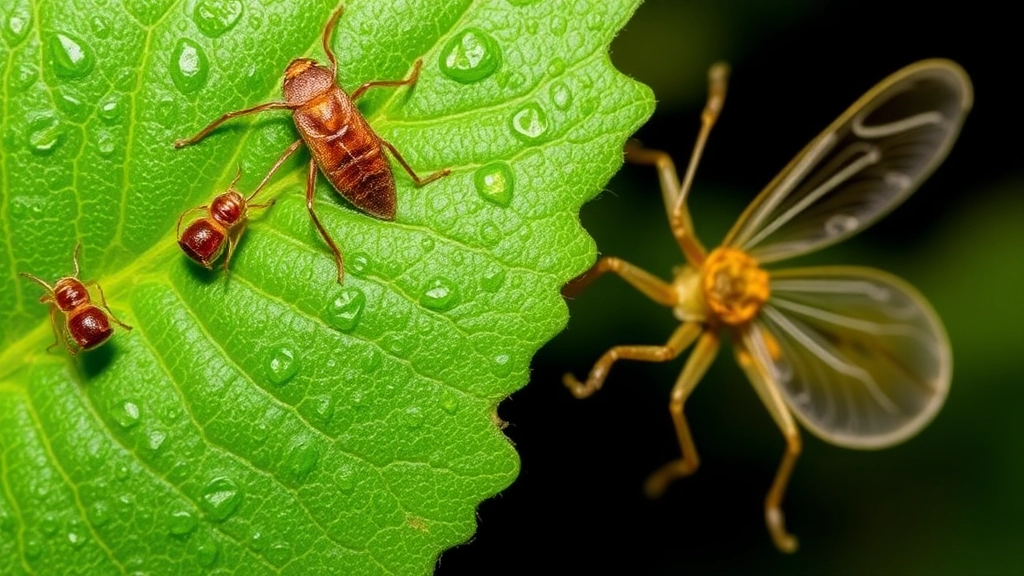
So, you’ve got your Calandiva Kalanchoe thriving, but what happens when those pesky pests show up or diseases start creeping in?
Let’s face it, nobody wants to see their beautiful plant wilting or covered in bugs.
Common Pests:
- Aphids
These tiny green or black bugs love to munch on your plant’s sap.
– Look for curled leaves or sticky residue (honeydew).
– A gentle spray of water can dislodge them, but for a serious infestation, consider insecticidal soap. - Mealybugs
These cottony little critters can be sneaky.
– Check for white, fluffy spots on the leaves and stems.
– Dab them with a cotton swab dipped in alcohol to zap them away. - Spider Mites
If you notice fine webbing, you might have spider mites.
– They thrive in dry conditions, so keep humidity in check.
– A good rinse under the tap can help, but you might need miticides for a heavy infestation. - Scale Insects
These look like little bumps on the plant.
– Scrape them off gently with your fingernail or use a cotton ball soaked in rubbing alcohol.
Common Diseases:
- Root Rot
This sneaky disease can strike if you overwater.
– Watch for yellowing leaves and mushy stems.
– If you suspect root rot, repot your plant in fresh soil and trim off any rotten roots. - Powdery Mildew
This white, powdery substance can appear on the leaves.
– Ensure good air circulation and avoid overhead watering.
– A mix of baking soda and water can help treat it. - Leaf Spot
Dark spots on your leaves? That’s likely leaf spot disease.
– Keep your leaves dry and remove affected leaves to prevent it from spreading.
Taking care of your Calandiva Kalanchoe means keeping an eye out for these pests and diseases.
When it comes to keeping your Calandiva Kalanchoe healthy and vibrant, pruning and maintenance are essential. Many plant enthusiasts worry about how to properly care for their Kalanchoe, especially when it starts to outgrow its space or look a bit untidy.
### Why Prune Your Calandiva Kalanchoe?
Pruning not only enhances the plant’s appearance but also promotes healthier growth. Here are some key reasons to consider:
– **Encourages New Growth**: Cutting back old blooms and leaves encourages the plant to produce fresh foliage and flowers.
– **Prevents Overcrowding**: Regular pruning helps maintain an ideal shape and prevents overcrowding, which can lead to disease.
– **Removes Dead or Diseased Parts**: This is crucial for the overall health of your plant.
### How to Prune Your Kalanchoe
Pruning your Calandiva Kalanchoe is straightforward. Here are some steps to follow:
1. **Use Clean Tools**: Always use sharp, sterilised scissors or pruning shears to avoid introducing bacteria.
2. **Identify Dead or Dying Leaves**: Look for any leaves that are yellowing or wilting. These should be removed at their base.
3. **Trim Back Flower Stems**: After blooming, cut back the flower stems to just above the first set of leaves.
4. **Shape the Plant**: If your Kalanchoe is becoming leggy, trim back the longer stems to encourage a bushier appearance.
### Maintenance Tips
In addition to pruning, regular maintenance will keep your Calandiva Kalanchoe thriving:
– **Dust Leaves**: Wipe the leaves gently with a damp cloth to keep them free from dust and pests.
– **Check for Pests**: Regularly inspect your plant for any signs of pests, such as aphids or mealybugs.
– **Rotate the Plant**: Occasionally rotate your Kalanchoe to ensure even light exposure.
By incorporating these pruning and maintenance practices, your Calandiva Kalanchoe will flourish and continue to be a stunning addition to your home. For more detailed care tips, you can refer to this [complete guide to Kalanchoe plant care](https://planthq.org/complete-guide-to-kalanchoe-plant-care/) and learn [how to make Kalanchoe bloom all summer](https://planthq.org/how-to-make-kalanchoe-bloom-all-summer-expert-tips/).
Propagation Methods for Calandiva Kalanchoe
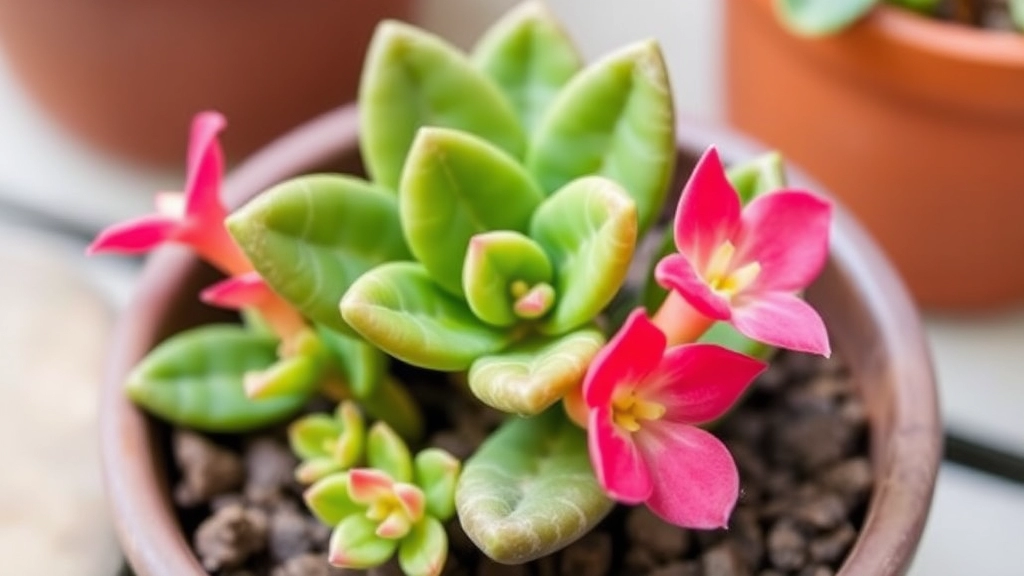
So, you’ve enjoyed your Calandiva Kalanchoe and now you’re thinking about spreading the joy?
Propagation is a fantastic way to expand your collection or share the love with friends.
Here are some simple and effective methods to propagate your Calandiva Kalanchoe:
1. Leaf Cuttings
- Choose a healthy leaf: Pick a plump, vibrant leaf from your plant.
- Cut it off: Use a clean, sharp knife or scissors to snip it at the base.
- Let it callus: Place the leaf on a paper towel for a day or two to allow the cut end to dry out and form a callus.
- Plant it: Stick the callused end into a well-draining soil mix. Water lightly.
2. Stem Cuttings
- Select a stem: Look for a healthy stem with a few leaves.
- Cut the stem: Snip it just below a leaf node.
- Callus time: Just like with leaf cuttings, let the end dry out for a day.
- Pot it up: Place it in soil and water sparingly until it roots.
3. Offsets
- Look for offsets: These are little baby plants that grow around the base of your Calandiva.
- Gently remove: Carefully separate them from the main plant, ensuring they have some roots.
- Replant: Pop them into their own pots with fresh soil.
4. Water Propagation
- Use a jar: Place a stem cutting in a jar of water, making sure the leaves don’t touch the water.
- Wait for roots: Change the water regularly and watch for roots to develop.
- Transfer to soil: Once roots are a few inches long, move it to soil.
Tips for Successful Propagation
- Warmth is key: Keep your cuttings in a warm, bright spot but out of direct sunlight.
- Humidity helps: Consider covering them with a plastic bag to maintain humidity, but don’t forget to ventilate!
- Patience pays off: It may take a few weeks for roots to form, so don’t rush it.
Propagation can be a rewarding experience, and soon enough, you’ll have a mini Calandiva garden thriving at home!
Benefits of Growing Calandiva Kalanchoe
Have you ever wondered why so many people are drawn to the Calandiva Kalanchoe plant?
This vibrant succulent offers numerous benefits that go beyond its stunning appearance.
Frequently Asked Questions (FAQs) about Calandiva Kalanchoe Plant
What are the ideal growing conditions for a Calandiva Kalanchoe?
To thrive, Calandiva Kalanchoe needs specific conditions such as temperatures between 15°C to 25°C, moderate humidity, and good air circulation. Indoors, a sunny windowsill works well, while outdoors, they prefer morning sun and afternoon shade in warmer climates.
What kind of pot should I use for my Calandiva Kalanchoe?
Choose a pot with drainage holes to prevent water from sitting at the bottom. Opt for a pot that’s slightly bigger than the root ball to avoid overwatering.
What are the light requirements for Calandiva Kalanchoe?
Calandiva Kalanchoe thrives in bright, indirect sunlight. It can tolerate some direct sunlight but prolonged exposure can scorch the leaves. Placing the plant near a south or west-facing window is ideal, and supplemental lighting may be needed during winter months.
What temperature range is best for Calandiva Kalanchoe?
The optimal temperature range for Calandiva Kalanchoe is between 18°C to 24°C (65°F to 75°F). Avoid exposing the plant to temperatures below 10°C (50°F) and protect it from cold drafts and extreme heat.
How can I prevent common pests on my Calandiva Kalanchoe?
Common pests include aphids, mealybugs, spider mites, and scale insects. Regularly inspect your plant for signs of these pests and use methods like water sprays, insecticidal soap, or rubbing alcohol to manage infestations.
What are some common diseases that affect Calandiva Kalanchoe?
Common diseases include root rot, powdery mildew, and leaf spot. To prevent these, ensure proper watering, good air circulation, and remove affected leaves promptly.
How can I propagate my Calandiva Kalanchoe?
Propagation methods include leaf cuttings, stem cuttings, offsets, and water propagation. Each method involves selecting healthy parts of the plant, allowing them to callus, and then planting them in well-draining soil or water.
What should I do if my Calandiva Kalanchoe gets root rot?
If you suspect root rot, repot your plant in fresh soil and trim off any rotten roots. Ensure you are not overwatering and that your pot has good drainage.
Can I grow Calandiva Kalanchoe indoors?
Yes, Calandiva Kalanchoe can be grown indoors. A sunny windowsill is perfect, but ensure it’s not too drafty and provides bright, indirect sunlight.
How can I ensure successful propagation of Calandiva Kalanchoe?
Keep your cuttings in a warm, bright spot out of direct sunlight, maintain humidity by covering them with a plastic bag, and be patient as it may take a few weeks for roots to form.
By following these guidelines and keeping an eye out for common issues, you can enjoy a thriving Calandiva Kalanchoe plant at home.
References
-
Caring For Kalanchoe: Tips On Growing Kalanchoe Plants
-
How to Grow and Care for Kalanchoe
-
Kalanchoe: How to Grow and Care for Kalanchoe Plants
